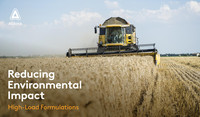
Insight into Dutch arable farmer’s black-grass control strategy

The farmer in the Oldambt-area, in the north east of The Netherlands, switched to later sowing of winter wheat and low-till soil treatment for a good stale seedbed. He also introduced more crops into his rotation and is also exploring options for mechanical weed control if glyphosate is banned.
“Black-grass is more or less under control, but you always have to be aware that the weed can pop-up somewhere again. If wheat fields start to look red from the amount of black-grass, you are in serious trouble,” says Bosma.
Ron Bosma (33) has an arable farm of 175 hectare on clay soil (65% lutum, pH 7 and 3,9% organic matter) in the Oldambt-area. He runs this in cooperation with his parents Thies (65) and Janneke (62).
The rotation covers 127 ha of winter wheat, 18 ha of sugar beet, 15 ha of onions and 15 ha of winter barley. Bosma and his wife Mariska (38) are the 5th generation farmers here. “The black-grass problem has existed for a long time, my father and grandfather had to cope with this problematic weed too,” he says. “They controlled black-grass with a very wide crop rotation with more spring and summer crops like beans, peas, caraway and oilseed rape.”
Limited number of products
About 15 years ago the product Atlantis (mesosulfuron + iodosulfuron) appeared on the market to help control black-grass in larger areas. In the first years this was very effective.
“We used this product in the spring, but black-grass developed resistance against Atlantis, making it less effective. Black-grass is already resistant against Puma (fenoxaprop), Topik (clodinafop) and Axial (pinoxaden). Up until 2 years ago we used Javelin which contained diflufenican + isoproturon, but black-grass is resistant to isoproturon. The number of products available against black-grass is too limited. That’s why we need other strategies to control it,” says Ron Rosma.
The Oldambt arable farmer experiences most problems in winter wheat. He uses the varieties Graham, KWS Talent, Bennington and Didero. In winter barley the problem with black-grass is somewhat smaller because of better soil coverage by leaves, smothering the emerged black-grass plants.
In barley, Bosma uses Herold (flufenacet + diflufenican) in combination with Malibu (flufenacet + pendimethalin). “In wheat fields with black-grass you can easily lose 20% yield. We want to avoid this by using a preventive approach,” says Bosma, who also wants to save costs on crop protection.
“Spring products like Capri Twin (pyroxsulam + florasulam) and Othello (mesosulfuron + iodosulfuron + diflufenican) are not cheap and also cause a setback in the crop. Next to that the weeds also compete with the wheat on nitrogen, meaning you would need more fertilizer to have the same yield.”
Black-grass is by far Bosma’s main challenge. Locally there are some issues with field horsetail, but this is controlled by spot spraying with MCPA.
Black-grass control
Eight years ago the Bosma family decided to go for another approach to control black-grass. Instead of ploughing at 25 cm, followed by a power harrow treatment, they went for low-tillage.
“Following the wheat harvest we treat the field in one pass with a power harrow to a depth of 10 cm and combine that with a flat lift cultivator up to 25 cm deep. With a plough you turn a new layer of soil to the surface. We keep the same soil layer on top, but this layer we keep clean. Black-grass seeds from deeper soil layers don’t come to the surface, like with ploughing. Seeds in the top 10 cm get the chance to germinate when treated with low-till, after which we can control it with glyphosate. This really gives you a good head start, a lot of black-grass and other weeds are then already gone.”
Just after seeding winter wheat, Bosma sprays the soil with herbicide Herold against black-grass and in barley he chooses Herold with Malibu. “Because the soil is more course and ‘more settled’ these products work more effectively,” according to Bosma, who also mentions other advantages of low-till: less tire tracks, less soil compaction and only one pass in the field.
“That saves fuel and labor. Next to that the organic matter remains in the top layer and the soil life is less affected compared to ploughing. Since there is no plough pan anymore, this helps the water permeability of the soil.”
Bosma chooses later seeding of his winter wheat, preferably not starting to seed before the second week of October. This gives him enough time to prepare a good stale seedbed which he can treat with glyphosate to control germinating black-grass. “In September a lot of black-grass germinates but from mid-October onwards this is far less.”
To sow 127 hectares of winter wheat and 15 hectares of barley in the most ideal circumstances, and also to avoid the risk of seeding too late, the Bosma family invested in 2014 in a 4-meter wide Väderstad Rapid seeder. “With this machine we doubled our seeding capacity and we can work in all circumstances. At maximum we can sow 30 hectares a day, while driving around 10 kilometers an hour, so this is really nice. The only disadvantage of seeding in October is that we have to apply slug pellets to prevent slug damage on the crop.”
Removing black-grass and crop rotation
The onions and sugar beet fields are also prepared in autumn. “We don’t like to apply a soil treatment in spring, since this can cause soil structure damage.”
Just before seeding onions and sugar beet Bosma sprays glyphosate for black-grass. “Together with my father, I spend two weeks in the onions and sugar beet fields removing black-grass plants by hand. Besides this we also use Gallant (haloxyfop) when spraying onions and sugar beet since this has also some efficacy against black-grass.”
Last spring the fields were quite clean. A sign that Bosma’s strategy is working. It’s important to remove black-grass plants in the spring as soon as possible when they appear above the wheat crop. “Hand rogueing is a lot of work, but you have no choice: the black-grass plants have to be removed before they start releasing their seeds. Otherwise all your previous efforts have been useless. Starting in May we spend quite some time on this and it’s really effective to stop the propagation of black-grass.”
In previous years Bosma used to have oilseed rape in the rotation. “We were able to use Kerb (propyzamid) against black-grass.” Crop rotation breaks the cycle of year-on-year growing cereals. This is needed because monocultures make it difficult to effectively control black-grass. The oilseed area is switched to onions, and the area of sugar beet has grown. With crop rotation it’s possible to alternate herbicides with different modes-of-action against black-grass and this reduces the risk of resistance build-up.
Mechanical weed control
“If glyphosate is banned, we have a serious problem,” says Bosma, and for this reason he is looking for possibilities of mechanical weed control. “When visiting an event, we got in contact with the importer of the Väderstad CrossCutter. We tried this machine in September 2018 and it really did a good job this year. A specially-designed disc in the machine cuts the top 3-cm-soil layer. You need to make sure that the weeds are not too big, so that the roots are not too large and too deep into the soil.” Next to that Bosma is waiting for a new crop protection product against black-grass. “In spring we are really looking for an effective solution. Because of resistance development the current products are not sufficient anymore.”



